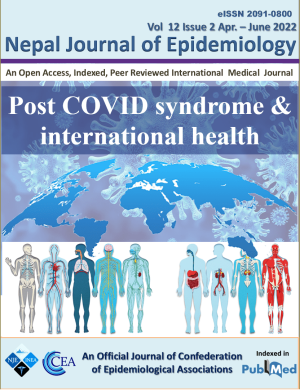Quarantine, physical distancing and social isolation measures in individuals potentially exposed to SARS-CoV-2 in community settings and health services: a scoping review
DOI:
https://doi.org/10.3126/nje.v12i2.43838Keywords:
Coronavirus, Confinement, Severe Acute Respiratory Syndrome, Physical DistancingAbstract
To provide a synthesis of diverse evidence on the impact of the non-therapeutic preventive measures, specifically quarantine, physical distancing and social isolation, on the control of COVID-19. A scoping review conducted in the PubMed, Embase, LILACS, CENTRAL and SCOPUS databases between 2019 and August 28th, 2020. The descriptors used were the following: “quarantine”, “physical distancing”, “social isolation”, “COVID-19” and “SARS-Cov2”. Studies that addressed the non-therapeutic preventive measures in people exposed to SARs-CoV-2 in community settings and health services were included. A total of 14,442 records identified through a database search were reduced to 346 studies and, after a standardized selection process, a total of 68 articles were selected for analysis. A total of 35 descriptive, cross-sectional or longitudinal observational studies were identified, as well as 3 reviews, in addition to 30 studies with mathematical modeling. The main intervention assessed was social distancing (56.6%), followed by lockdown (25.0%) and quarantine (18.4%). The main evidence analyzed points to the need for rapid responses to reduce the number of infections, deaths and hospital admissions, especially in intensive care unit beds.The current review revealed consistent reports that the quarantine, physical distancing and social isolation are effective strategies to contain spread of the new coronavirus.
Downloads
Downloads
Published
How to Cite
Issue
Section
License
Copyright (c) 2022 CEA & INEA

This work is licensed under a Creative Commons Attribution 4.0 International License.
- Upon acceptance Copyright on any research article is transferred in full to the Confederation of Epidemiological Associations (CEA) and International Nepal Epidemiological Association (INEA). The copyright transfer includes the right to reproduce and distribute the article in any form of reproduction (printing, electronic media or any other form).
- Articles in the Nepal Journal of Epidemiology are Open Access articles published under the Creative Commons CC BY License (https://creativecommons.org/licenses/by/4.0/)
- This license permits use, distribution and reproduction in any medium, provided the original work is properly cited.




